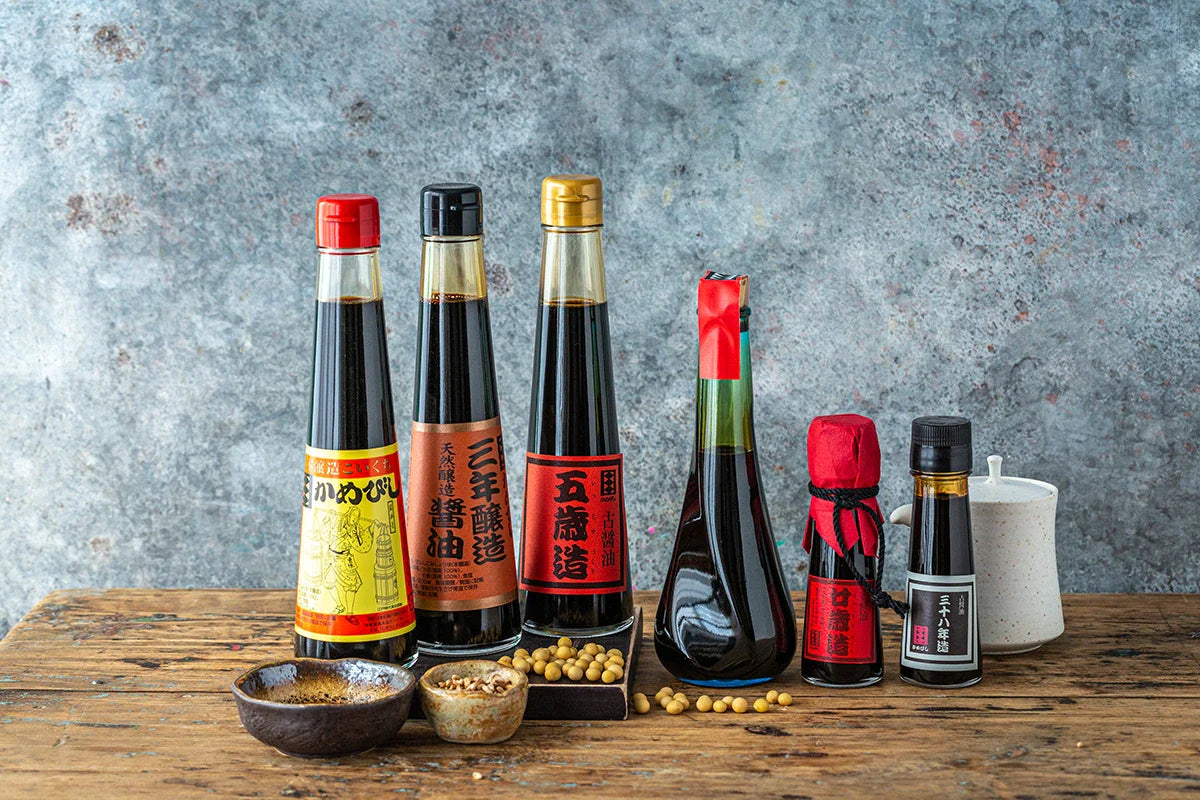
Japanese food culture is known for its rich and diverse cuisine, with flavours that are unmatched by any other country. At the heart of Japanese cooking lies a key ingredient - soy sauce. While most people may associate soy sauce with just being a condiment for sushi or stir fry, it is actually an incredibly versatile ingredient that can be used in many Japanese dishes. Read on to learn more about Japanese soy sauces.
What is Japanese soy sauce and what is it made of?
Japanese soy sauce, or shoyu, is a condiment made from fermented soy beans, wheat, salt and water. The traditional production process involves fermenting the ingredients in large barrels for months to create a rich and complex flavour. The quality of the soy sauce depends on factors such as the type of soybeans used, the ratio of soybeans to wheat, and the length of fermentation. This delicate balance is what gives Japanese soy sauce its unique and delicious taste.

What is the most common type of Japanese soy sauce?
There are primarily two types of soy sauce used in Japanese cuisine - koikuchi shoyu and usukuchi shoyu.
Koikuchi shoyu, also known as "dark" or "regular" soy sauce, is the most commonly used type of soy sauce in Japan. It has a deep, rich flavour and is often used as a general seasoning for dishes such as teriyaki and ramen.
On the other hand, usukuchi shoyu, also known as "light" or "thin" soy sauce, has a lighter colour and flavour due to its higher wheat content.
What’s the difference between Japanese soy sauce and other soy sauces?
Of course, there isn't only Japanese soy sauce. While Japanese soy sauce shares similarities with other types of soy sauce, there are some key differences that distinguish it from its counterparts. For example, Chinese soy sauce tends to be thicker and sweeter than Japanese soy sauce, due to the use of different ratios of wheat to soybeans during fermentation.
Additionally, Japanese light and dark soy sauces have different applications in cooking - while dark soy sauce is used more for seasoning and adding colour, light soy sauce is often used as a finishing touch to enhance the flavour of a dish.
Best ways to use Japanese soy sauce to level up your Japanese cuisine
Japanese soy sauce is an incredibly versatile ingredient that can be used in various ways.
It can be used as a marinade for meats, added to miso soup and ramen noodles for a rich umami flavour, and even used to season sushi rice.
For seafood dishes like sashimi or grilled fish, a light drizzle of Japanese soy sauce can bring out the natural flavours without overpowering them.
It is also commonly used as a dipping sauce for udon noodles or tempura. The key is to use it sparingly as a little goes a long way in enhancing the flavours of your dishes.
Best Japanese soy sauces to buy
Now that we know a bit more about Japanese soy sauce and how to use it, let's take a look at some of the best types and brands to buy. Different soy sauces have different purposes and flavours, so it's important to choose the right one for your dish.
Koikuchi Shoyu (dark soy sauce)
A soy sauce that's great for most general cooking. It's widely available in most grocery stores and works well with various dishes. If you're new to Japanese cooking and looking for a good quality soy sauce that won't break the bank, Kikkoman is a great entry-level choice but if you’re looking for premium koikuchi shoyu, we recommend our 2 year aged soy sauce from Kamebishi.
Usukuchi Shoyu (Light Soy Sauce)
For those who prefer a lighter, more delicate flavour, this light soy sauce can be a great choice. It's made with high-quality soybeans and has a rich yet subtle taste. Most big brands like Kikkoman will have a light soy sauce available, but Marushima is also a beginner-friendly choice.
Tamari
Used as dipping sauce, glazing sauces or marinades, tamari is a gluten-free option for those with dietary restrictions. It has a slightly richer and thicker consistency than regular soy sauce, making it perfect for dipping sushi in. Try our Hon Tamari Soy Sauce for a high-quality option, or alternatively, a vegan Tamari option.
White soy sauce
White soy sauce, or shiro shoyu, is a lighter and sweeter version of regular soy sauce. It's made with mainly wheat and only a small amount of soybeans, giving it a pale colour and milder taste. This type of soy sauce is perfect for adding depth to dishes without darkening the appearance too much.
If you're adamant on something ideal for adding great flavour without darkening the colour of the dish at all, you can also use a crystal clear soy sauce.
Organic soy sauce
For those looking for a more natural and organic option, there are plenty of choices available. For example, the Yugeta Organic Soy only contains four simple ingredients - soybeans, wheat, salt and water.
Yuzu soy sauce
A popular variation of soy sauce in Japan, yuzu soy sauce is made by infusing regular soy sauce with yuzu juice. Yuzu is a citrus fruit commonly used in Japanese cooking and gives the soy sauce a refreshing, tangy flavour. It can be used as a dipping sauce for hot pot or added to salad dressings for a unique citrus twist.
Smoked soy sauce
If you're feeling adventurous and looking for a unique smoky flavour, try a smoked soy sauce. This soy sauce’s smoking process begins after the soy sauce has been fermented, in a chamber filled with smoke from cherry wood chips. It can add a rich, smoky flavour to meats and vegetables and is perfect for grilling or roasting.
Double fermented soy sauces
For this type of soy sauce, the double fermentation process makes the flavour stronger and more umami than any other sauces. This soy sauce works well as a dipping sauce. We recommend our popular Nama Shoyu, made only from premium quality soybeans.
Year aged soy sauces
For those who are willing to splurge on a premium soy sauce, consider trying aged soy sauces like kamebishi or yamaroku, which have been aged for years to develop a deep and intense flavour. From 2 year aged soy sauces, to 38 year aged soy sauces, these are definitely worth trying for a special occasion or to impress your guests with the highest quality soy sauce.
Purchase high quality soy sauce sets
If you're a real fan of authentic Japanese soy sauce, you can even purchase sets that include different types of soy sauce for you to try and compare.
Connoisseurs Soy Sauce Collection
This set of 3 soy sauces are all crafted by artisans using authentic production methods that have not changed for hundreds of years.
- Smoked Soy Sauce 210ml
- Nama Shoyu Soy Sauce 150ml
- 3 Year Old Soy Sauce 200ml
Aged Soy Sauce Set
The perfect taster treat set, decide for yourself which you prefer and taste the difference between these 3 differently aged Japanese shoyu. These 50ml bottles come packaged in a gift box and also make a great present.
- 2 Year Aged Soy Sauce 50ml
- 3 Year Aged Soy Sauce 50ml
- 5 Year Aged Soy Sauce 50ml
3 Year Aged Soy Sauce with Pourer & Dishes
Looking for a gift or a treat for yourself? This set includes a premium quality 3 year aged soy sauce, as well as ceramic dishes and a pourer for an elegant dining experience.
- 3 Year Aged Kamebishi Soy Sauce, 200ml
- Black Soy Sauce Pourer
- Akane Grey Soy Sauce dish x 2

